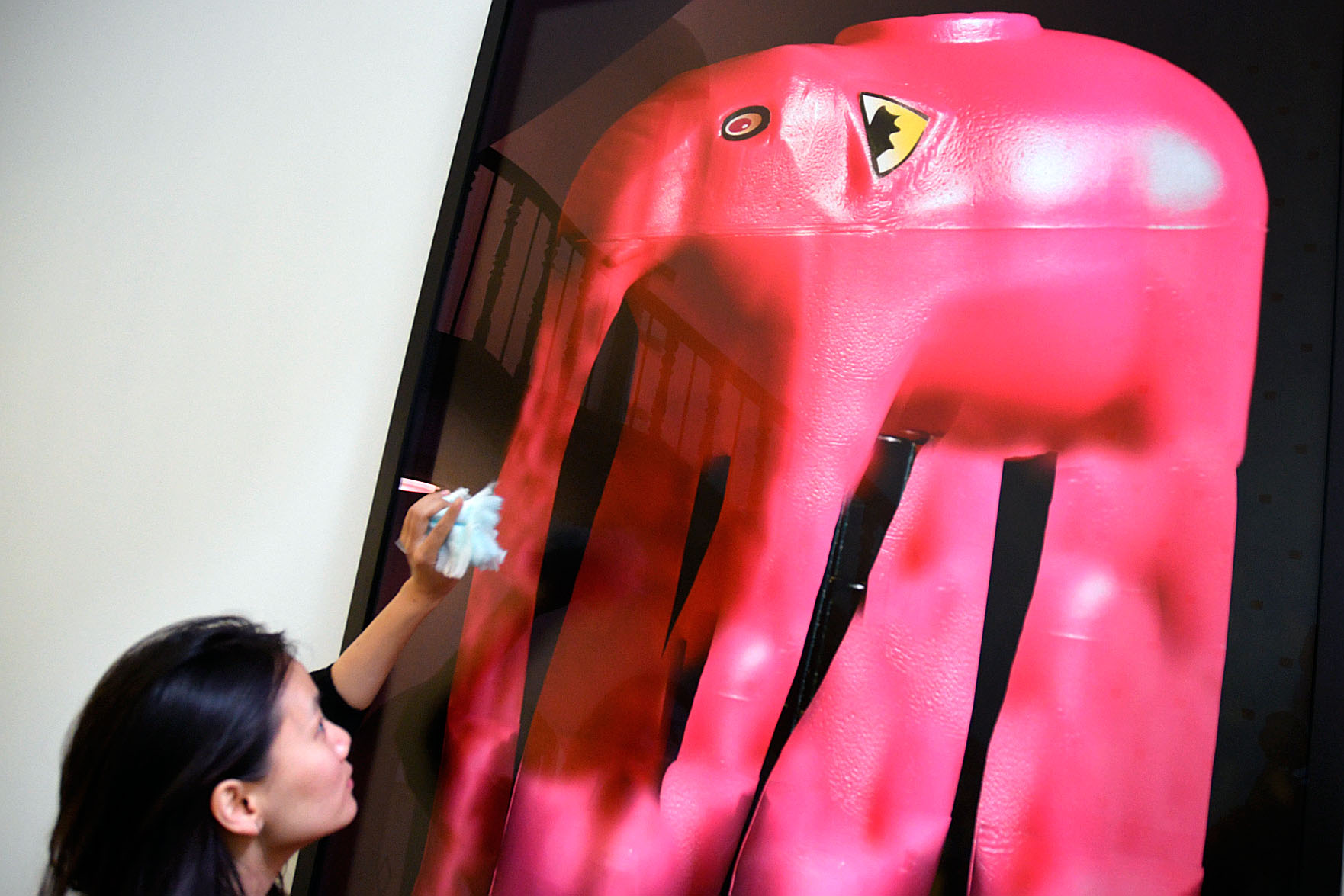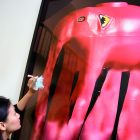Kein Appetit
„Besser vorher gut gegessen“, möchte man Besuchern des Museums Kurhaus Kleve raten, wenn sie sich nächstens zur neuen Ausstellung auf den Weg machen.
Mit leerem Magen könnte der Besuch zur Versuchung werden. Wer möchte sich schon im Aggregatszustand „Hunger!“ mannshohen Bockwurstabbildungen aussetzen? Gleich zwei der Räume im Untergeschoss auf dem Weg zur großen Wandelhalle sind ganz und gar „verwurstet“. Man muss also standhaft bleiben.
Mehr als Spielerei
Der uns dies beschert, ist der amerikanische Künstler Lucas Blalock. Und nur um dem allzu dunklen Ahnungen vorzubeugen: Der Mann hat mehr zu bieten als nur Bockwurstvariationen. Was Blalock im Kurhaus aufgebaut hat, ist seine erste große Einzelausstellung in Europa. Blalock hat den Laden übernommen und so viel sei gesagt: Es handelt sich um eine freundliche Übernahme. Da lotet einer Grenzen aus. Es sind die Grenzen der Fotografie. Blalock findet dabei zu einer Fotografie, die Eingriffe sichtbar macht.
Blalock geht so: Man muss die Realität (was ist das schon? ) nicht so lassen wie vorgefunden. Nun gut – diese Idee ist nicht neu, aber die Art, wie Blalock sich von den Vorgaben des Realen löst, um sie im nächsten Augenblick auszustellen, als seien sie das Wirkliche, ist mehr als eine Spielerei. Ist das Dadaismus mit der Kamera? Vielleicht. Wer will das sagen? Mit Schubladen hantiert, wer hilflos ist oder etwas zu beweisen hat.
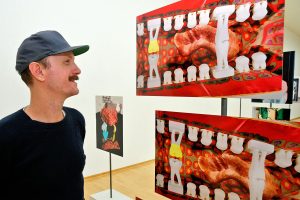
Lucas Blalock im Kurhaus.
Foto: Rüdiger Dehnen
Copy and paste
Blalocks Kunst kommt nicht daher als wolle sie etwas beweisen. Sie lässt Zusammenhänge entstehen, die man vorher nicht gedacht hatte. Gut – das ist auch mit realistischer Fotografie zu erreichen. Blalocks Bilder sparen allerdings nicht an einer ironisch kommentierenden Note. Er entstellt ein Gesicht, indem er es mit „copy and paste“ aus sich selbst neu zusammenaddiert. Auf einem dreistockwerkhohen Bild glaubt man Brechts Augen zu erkennen – eigentlich ist es der Haarschnitt. Am Ende spielt es keine Rolle, ob‘s der Berthold ist.
Auf anderen Bildern schweben Schnurrbärte durchs Reale – Schnurrbärte, wie Scherzkekse sie auf Wahlplakate malen. Und siehe da: Nebenbei erfährt man von Kuratorin Susanne Figner, dass Blalock Fan von allerlei lustigen Menschen ist. Jacques Tati gehört dazu. Buster Keaton auch. Na bitte – da ist einer nicht mit der Kunst zum Ewig-Ernsten geworden.
Im Begleittext liest man, dass der Blalock sich mit … genau: Brecht und dessen Verfremdungstechnik, (die sich freilich aufs Theater bezog) befasst und auseinandergesetzt hat. Eigentlich ist es nicht so sehr eine Auseinander- als eine Zusammensetzung. Und noch etwas erfährt man: Auf jeder Bildrückseite („Das würden Sie normalerweise gar nicht sehen!“, sagt die Kuratorin) – auf jeder Bildrückseite gibt es ein weiteres Bild. Heimlich ist es da. Twee halen, een betalen, denkt man.
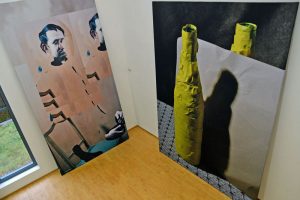
Foto: Rüdiger Dehnen
Fake News
Eigentlich wär‘s ja ein Geheimnis. Aber was ist schon geheim in einer Welt wie der unseren? Blalocks Bilder sind, um in dieser Welt zu bleiben, irgendwie Fake News mit Ansage. „Wenn du‘s glaubst“, scheint da einer zu sagen, „wenn du‘s glaubst, kann ich auch nichts machen.“
Vielleicht ist, was wir gezeigt und somit zu sehen bekommen, ein Kaleidoskop der Unmöglichkeiten, die sich vom Realen weggelebt haben und nun ein eigenes skurriles Dasein führen. Insofern ist die Bockckwurstinvasion des Anfangs (Blalock nennt sie „Vienna Studies“) ein schönes Entree: Auf- und Abreger, Vor- und Nachspeise, An- und Abturner. Blalock jedenfalls hat das Kurhaus übernommen und: er macht Gefangene. Zwei Dinge sind wichtig: Man muss die Bereitschaft mitbringen, sich fesseln zu lassen und: Die Handschellen allerdings muss man selber mitbringen.
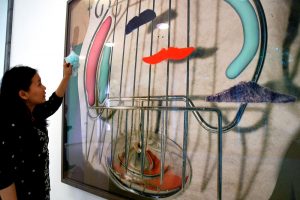
Fliegende Bärte
Foto: Rüdiger Dehnen
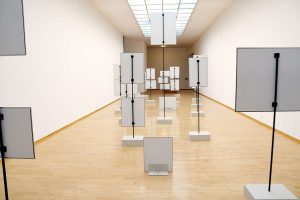
Foto: Rüdiger Dehnen
Friendly Takeover or: The Sausage Empire
Translation: Alexander Schlutz
No apetite
“Better eat well beforehand” is the advice one would want to give to the visitors of the Museum Kurhaus Kleve who may be heading soon to the new exhibition.
On an empty stomach, the visit might turn into a temptation. Who, after all, would want to expose themselves in the aggregate state of “hunger” to head-high representations of sausages? No less than two rooms on the basement level on the way to the great hall are completely given over to sausages. One needs to resist.
More than a gimmick
Bestowing all this on us is the American artist Lucas Blalock. And just to prevent all-too-dark premonitions: This man has more to offer than sausage variations. What Blalock has built in the Kurhaus is his first large solo exhibition in Europe. Blalock took over the joint, and to say just this much: It is a friendly takeover. Somebody is probing limits. These are the limits of photography. This way, Blalock comes to a photography that makes interventions visible.
This is how Blalock works: One doesn’t have to leave reality (what is that after all?) the way one found it. OK – that idea isn’t new, but the way in which Blalock frees himself from the guidelines of the real, in order to exhibit them in the next moment is if they were real, is more than a gimmick. Is that dadaism with a camera? Perhaps. Who wants to say so? He who is helpless, or he who has something to prove, trades in little boxes.
Copy and Paste
Blalock’s art does not present itself as if it had something to prove. It lets connections appear that one hadn’t thought before. Alright – one can do that with realistic photography as well. Blalock’s images, however, do not economize when it comes to overtones of ironic commentary. He disfigures a face by reconstituting it from its own elements via copy and paste. In an image that is three stories high one believes to recognize Brecht’s eyes – actually it is the haircut. In the end it doesn’t matter if it’s Berthold or not.
On other images, mustaches float through the real – mustaches of the kind jokesters draw on political posters. And wouldn’t you know: As an aside one learns from curator Susanne Figner that Blalock is a fan of a host of funny people. Jacques Tati is one of them. Buster Keaton another. There you go – this time art has not turned somebody eternally serious.
In the accompanying text one reads that Blalock engages and did concern himself with … exactly, Brecht and his technique of alienation (which the latter developed in the context of the theatre of course). Actually it is not so much a concerning-oneself-with as a combination. And one discovers another thing: On the back of every image (“Normally you wouldn’t see any of that,” says the curator) – on the back of every image is another image. Hiding there in secret. Buy one, get one free, one thinks.
Fake News
Actually it would be a mystery. But what is still a mystery in a world like ours? Blalock’s images are, to stay in this world, somehow self-announced fake news. “If you believe it,” someone seems to say here, “if you believe it, there’s nothing I can do.”
Maybe what we are shown and get to see this way is a caleidoscope of impossibilities that have left the real behind and now live their own bizarre existence. For this reason, the sausage invasion of the beginning (Blalock calls it “Vienna Studies”) is a nice prelude: Excitement and calm down, starter and desert, turn on and turn off. Blalock in any case has taken over the Kurhaus and he does take prisoners. Two things are important: One has to be ready to be captivated, and: it’s bring-your-own handcuffs.
